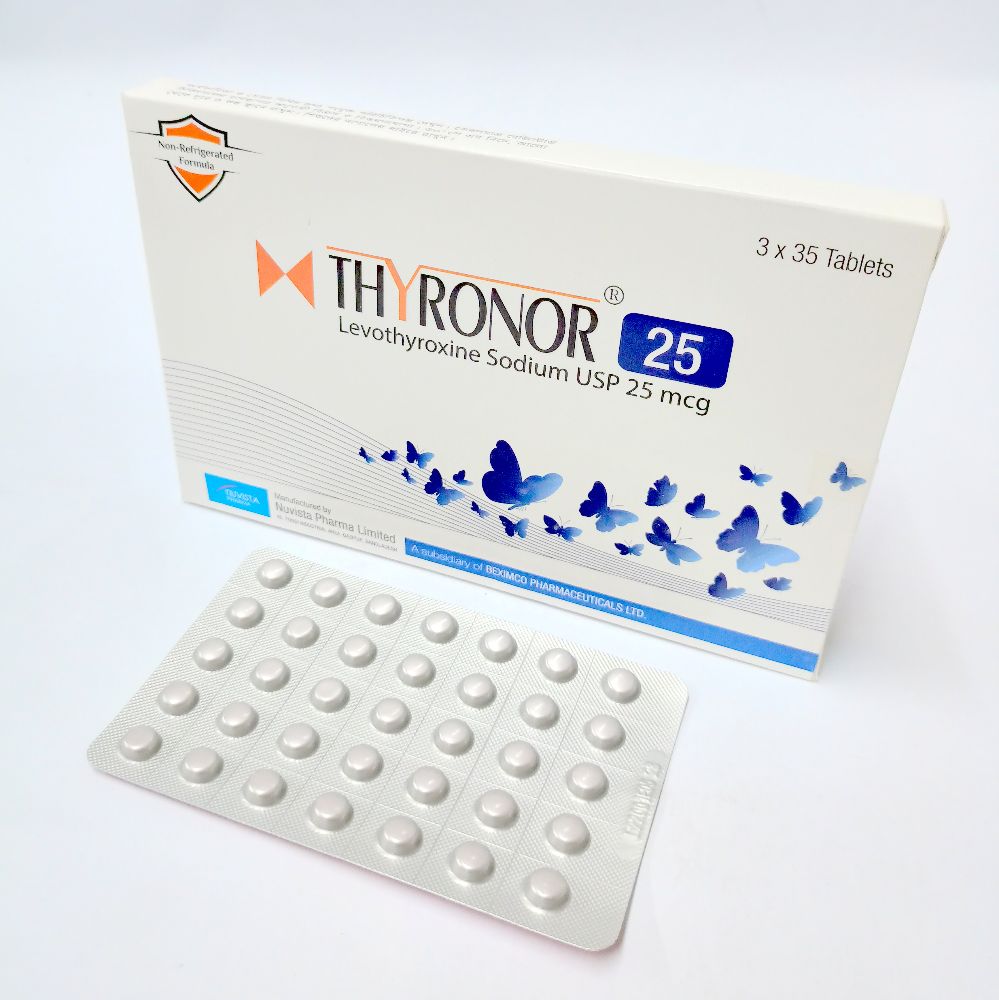
Type:105 Tablets
Generic Name:Levothyroxine Sodium
Manufacturer:Nuvista Pharma Ltd
Price:৳116.55
Hypothyroidism, TSH suppression, Myxoedema coma
Should be taken on an empty stomach with full glass of water. Take on an empty stomach ½-1 hr before meals.
Oral Mild Hypothyroidism 1.7 mcg/kg or 100-125 mcg PO qDay; not to exceed 300 mcg/day >50 years (or <50 yr with CV disease) Usual initial dose: 25-50 mcg/day May adjust dose by 12.5-25 mcg q6-8Week >50 years with CV disease Usual initial dose: 12.5-25 mcg PO qDay May adjust dose by 12.5-25 mcg q4-6weeks until patient becomes euthyroid and serum TSH concentration normalized; adjustments q6-8weeks also used Dose range: 100-125 mcg PO qDay Severe Hypothyroidism Initial: 12.5-25 mcg PO qDay Adjust dose by 25 mcg/day q2-4Week PRN Subclinical Hypothyroidism Initial: 1 mcg/kg PO qDay may be adequate, OR If replacement therapy not initiated, monitor patient annually for clinical status TSH suppression For thyrotropin-dependent well-differentiated thyroid cancer: Doses >2 mcg/kg/day may be given as a single dose to suppress TSH to <0.1 MIU/L. For benign nodules and nontoxic multinodular goitre: Target TSH is generally higher at 0.1-0.5 MIU/L for nodules and 0.5-1 MIU/L for multinodular goitre.
Oral Hypothyroidism Age 1-3 months 10-15 mcg/kg/day PO Use lower starting dose (25 mcg/day) if patient at risk of cardiac failure; if initial serum T4 lower than 5 mcg/dL begin treatment at higher dose (50 mcg/day) Age 3-6 months 8-10 mcg/kg/day PO, OR 25-50 mcg/day PO Age 6-12 months 6-8 mcg/kg/day PO, OR 50-75 mcg/day PO Age 1-5 years 5-6 mcg/kg/day PO, OR 75-100 mcg/day PO Age 6-12 years 4-5 mcg/kg/day PO, OR 100-125 mcg/day PO >12 years 2-3 mcg/kg/day PO, OR 150 mcg/day PO Start children with severe or chronic hypothyroidism at 25 mcg/day; adjust dose by 25 mcg qweek
Untreated hyperthyroidism; uncorrected adrenal failure; recent MI.
Levothyroxine Na is a synthetic form of thyroxine which increases the basal metabolic rate (BMR) and the utilisation and mobilisation of glycogen stores and stimulates protein synthesis. It is also involved in normal metabolism, growth and development. These effects are mediated at the cellular level by the thyroxine metabolite, tri-iodothyronine.
Patients w/ CV (e.g. angina, heart failure, HTN), DM and diabetes insipidus, epilepsy, pre-existing myasthenia syndrome, long-standing hypothyroidism. Elderly, pregnancy and lactation. Monitoring Parameters Monitor thyroid function test, clinical signs of hypo- and hyperthyroidism, heart rate and BP. Lactation: Enters breast milk; use caution
Nervousness, excitability, tremor, muscle weakness, fatigue, cramps; sweating, flushing, heat intolerance, headache, fever, insomnia, tachycardia, palpitations, restlessness, anginal pain, HTN, severe depression, difficulty in sleeping, excessive wt loss; menstrual irregularities; diarrhoea, vomiting, psychosis or agitation. Increased bone resorption and reduced bone mineral density, especially in post-menopausal women; elevated LFT. Potentially Fatal: Thyrotoxic crisis including convulsions, cardiac arrhythmia, heart failure, coma.
Reduced absorption w/ iron, antacids, bile acid sequestrants, colestyramine, simeticone, Ca carbonate, sucralfate, cation exchange resins. Reduced tri-iodothyronine serum levels w/ amiodarone and propranolol. Reduced serum levels of thyroxine w/ carbamazepine, phenytoin, phenobarbital, rifampicin, lithium, oestrogens, sertraline. Androgens may decrease levothyroxine-binding globulins serum levels. May alter requirements of antidiabetic drugs. Increased risk of significant HTN and tachycardia w/ ketamine. Increased metabolic demands w/ sympathomimetics (e.g. epinephrine). May increase anticoagulant effect of warfarin.